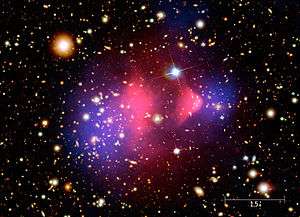Korea Invisible Mass Search
The Korea Invisible Mass Search (KIMS), is a South Korean experiment, led by Sun Kee Kim, searching for weakly interacting massive particles (WIMPs), one of the candidates for dark matter.[1] The experiments use CsI(Tl) crystals at Yangyang Underground Laboratory (Y2L), in tunnels from a preexisting underground power plant.[2] KIMS is supported by the Creative Research Initiative program of the Korea Science and Engineering Foundation. It is the first physics experiment located, and largely built, in Korea.[3]
Other research topics include detector development for a neutrinoless double beta decay search and the creation of an extreme low temperature diamond calorimeter.
History
The KIMS experiment was funded in 2000 to search for WIMP dark matter. To avoid the cost of creating a new tunnel for testing, the Yangyang Pumped Storage Power Plant belonging to Korea Middleland Power Co. in Yangyang, Korea was used. Construction was completed in 2003. The CsI(Tl) scintillating crystal used has a high light yield and is affordable for large mass. After a substantial effort for the initial setup and crystal development, KIMS began recording data in 2004 with one full-size 6 kg crystal.[2] A 4 crystal setup was run in 2005-2006 to optimize the WIMP search. In 2008, the 12 crystal array with 103.4 kg mass was completed and ran until December 2012 for a detector upgrade replacing the PMTs.
Results
The first WIMP cross section search was published in 2006 using the one crystal data.[4] New limits were presented in 2007 and 2012,[5] inconsistent with the DAMA signal reports for masses above 20 GeV. Using 24324.3 kg days exposure, low-mass WIMP signals below 20 GeV were disfavored[6] in 2014.
COSINE
The KIMS and DM-Ice groups have joined forces to make a new detector consisting of an array of NaI(Tl) scintillating crystals to confirm or refute the DAMA/LIBRA results. As of July 2016, the 100 kg COSINE-100 experiment had been installed at Y2L.[7] In September 2016, physics data started to be collected.[8] The next version of the COSINE detector, COSINE-200, will be constructed in Yemi Laboratory in Jeongseon County.
The COSINE-100 published its first results on 5 December 2018 in Nature; they concluded that their result "rules out WIMP–nucleon interactions as the cause of the annual modulation observed by the DAMA collaboration".[9] This rejection applies only to WIMPs with one of the 18 tested masses, exhibiting spin-independent interactions with sodium or iodine nucleons, within the context of a standard dark matter halo model.
References
- The Journal of the Korean Physical Society. Korean Physical Society. 2005.
- Kiwoon Choi; Jihn E. Kim; Dongchul Son (12 December 2005). Particles, Strings and Cosmology: 11th International Symposium on Particles, Strings and Cosmology; PASCOS 2005. Springer. pp. 75–81. ISBN 978-0-7354-0295-9.
- Symmetry: Dimensions of Particle Physics. Fermi National Accelerator Lab. 2006.
- KIMS Collaboration (9 February 2006). "First limit on WIMP cross section with low background CsI(Tℓ) crystal detector". Phys. Lett. B. 633 (2–3): 201–208. arXiv:astro-ph/0509080. Bibcode:2006PhLB..633..201K. doi:10.1016/j.physletb.2005.12.035.
- Kim, S.C.; et al. (30 April 2012). "New Limits on Interactions between Weakly Interacting Massive Particles and Nucleons Obtained with CsI(Tl) Crystal Detectors". Phys. Rev. Lett. 108 (181301): 181301. arXiv:1204.2646. Bibcode:2012PhRvL.108r1301K. doi:10.1103/PhysRevLett.108.181301. PMID 22681055.
- Lee, H.S.; et al. (23 September 2014). "Search for low-mass dark matter with CsI(Tl) crystal detectors". Phys. Rev. D. 90 (52006): 052006. arXiv:1404.3443. Bibcode:2014PhRvD..90e2006L. doi:10.1103/PhysRevD.90.052006.
- Ha, Chang Hyon (20 July 2016). Status of the COSINE experiment. Identification of Dark Matter 2016. Sheffield.
- "COSINE-100 Experiment". COSINE-100 Dark Matter Experiment. Yale. Retrieved 29 October 2018.
COSINE-100 has started taking physics data on September 2016, so stay tuned for our first physics result!
- The COSINE-100 Collaboration (5 December 2018). "An experiment to search for dark-matter interactions using sodium iodide detectors". Nature. 564 (7734): 83–86. arXiv:1906.01791. Bibcode:2018Natur.564...83C. doi:10.1038/s41586-018-0739-1. PMID 30518890.
